LEXUS GS300H 2019 Owners Manual
Manufacturer: LEXUS, Model Year: 2019, Model line: GS300H, Model: LEXUS GS300H 2019Pages: 600, PDF Size: 55.99 MB
Page 271 of 600
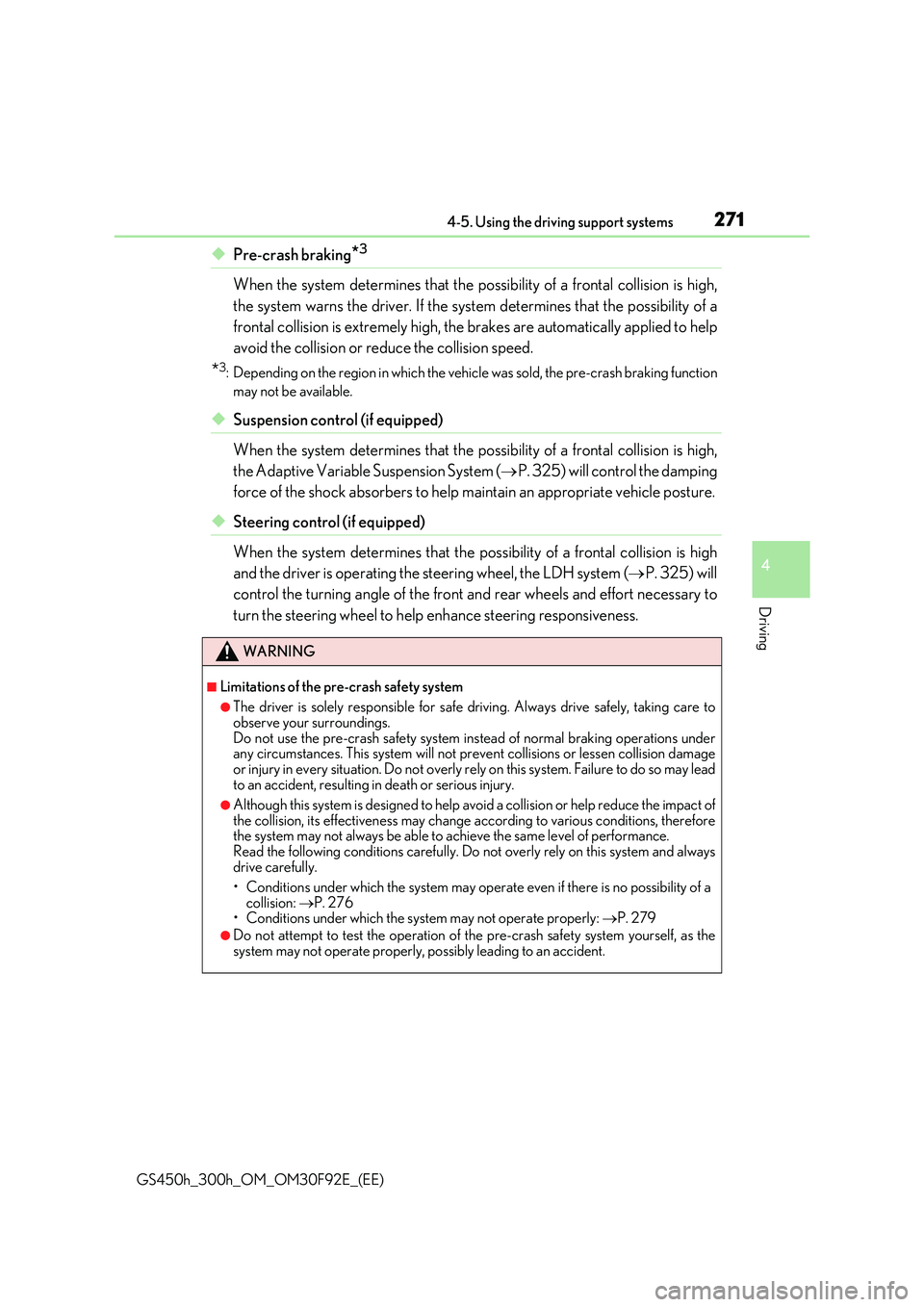
2714-5. Using the driving support systems
4
Driving
GS450h_300h_OM_OM30F92E_(EE)
◆Pre-crash braking*3
When the system determines that the possibility of a frontal collision is high,
the system warns the driver. If the system determines that the possibility of a
frontal collision is extremely high, the brakes are automatically applied to help
avoid the collision or reduce the collision speed.
*3: Depending on the region in which the vehicle was sold, the pre-crash braking function
may not be available.
◆Suspension control (if equipped)
When the system determines that the possibility of a frontal collision is high,
the Adaptive Variable Suspension System ( P. 325) will control the damping
force of the shock absorbers to help maintain an appropriate vehicle posture.
◆Steering control (if equipped)
When the system determines that the possibility of a frontal collision is high
and the driver is operating the steering wheel, the LDH system ( P. 325) will
control the turning angle of the front and rear wheels and effort necessary to
turn the steering wheel to help enhance steering responsiveness.
WARNING
■Limitations of the pre-crash safety system
●The driver is solely responsible for safe driving. Always drive safely, taking care to
observe your surroundings. Do not use the pre-crash safety system instead of normal braking operations underany circumstances. This system will not pr event collisions or lessen collision damage
or injury in every situation. Do not overly re ly on this system. Failure to do so may lead to an accident, resulting in death or serious injury.
●Although this system is designed to help avoid a collision or help reduce the impact of
the collision, its effectiveness may change according to various conditions, therefore the system may not always be able to achieve the same level of performance.
Read the following conditions carefully. Do not overly rely on this system and always drive carefully.
• Conditions under which the system may oper ate even if there is no possibility of a
collision: P. 276 • Conditions under which the system may not operate properly: P. 279
●Do not attempt to test the operation of the pre-crash safety system yourself, as the system may not operate properly, possibly leading to an accident.
Page 272 of 600

2724-5. Using the driving support systems
GS450h_300h_OM_OM30F92E_(EE)
WARNING
■Pre-crash braking*3
●When the pre-crash braking function is operating, a large amount of braking force will be applied.
●If the vehicle is stopped by the operation of the pre-crash braking function, the pre-crash braking function operation will be canceled after approximately 2 seconds.Depress the brake pedal as necessary.
●The pre-crash braking function may not operate if certain operations are performedby the driver. If the accelerator pedal is being depressed strongly or the steeringwheel is being turned, the system may determine that the driver is taking evasive
action and possibly prevent the pre-crash braking function from operating.
●In some situations, while the pre-crash braking function is operating, operation of thefunction may be canceled if the accelerator pedal is depressed strongly or the steer-
ing wheel is turned and the system determines that the driver is taking evasive action.
●If the brake pedal is being depressed, the system may determine that the driver is tak-ing evasive action and possibly delay the operation timing of the pre-crash braking
function.
*3: Depending on the region in which the vehicle was sold, the pre-crash braking func-
tion may not be available.
■When to disable the pre-crash safety system
In the following situations, disable the system, as it may not operate properly, possibly
leading to an accident resulting in death or serious injury:
●When the vehicle is being towed
●When your vehicle is towing another vehicle
●When transporting the vehicle via truck, boat, train or similar means of transportation
●When the vehicle is raised on a lift with the hybrid system on and the tires are allowed to rotate freely
●When inspecting the vehicle using a drum tester such as a chassis dynamometer orspeedometer tester, or when using an on vehicle wheel balancer
●When a strong impact is applied to the front bumper or front grille, due to an accident
or other reasons
●If the vehicle cannot be driven in a stable manner, such as when the vehicle has beenin an accident or is malfunctioning
●When the vehicle is driven in a sporty manner or off-road
●When the tires are not properly inflated
●When the tires are very worn
●When tires of a size other than specified are installed
●When tire chains are installed
●When a compact spare tire or an emergency tire puncture repair kit is used
●If equipment (snow plow, etc.) that may obstruct the radar sensor or camera sensor istemporarily installed to the vehicle
Page 273 of 600
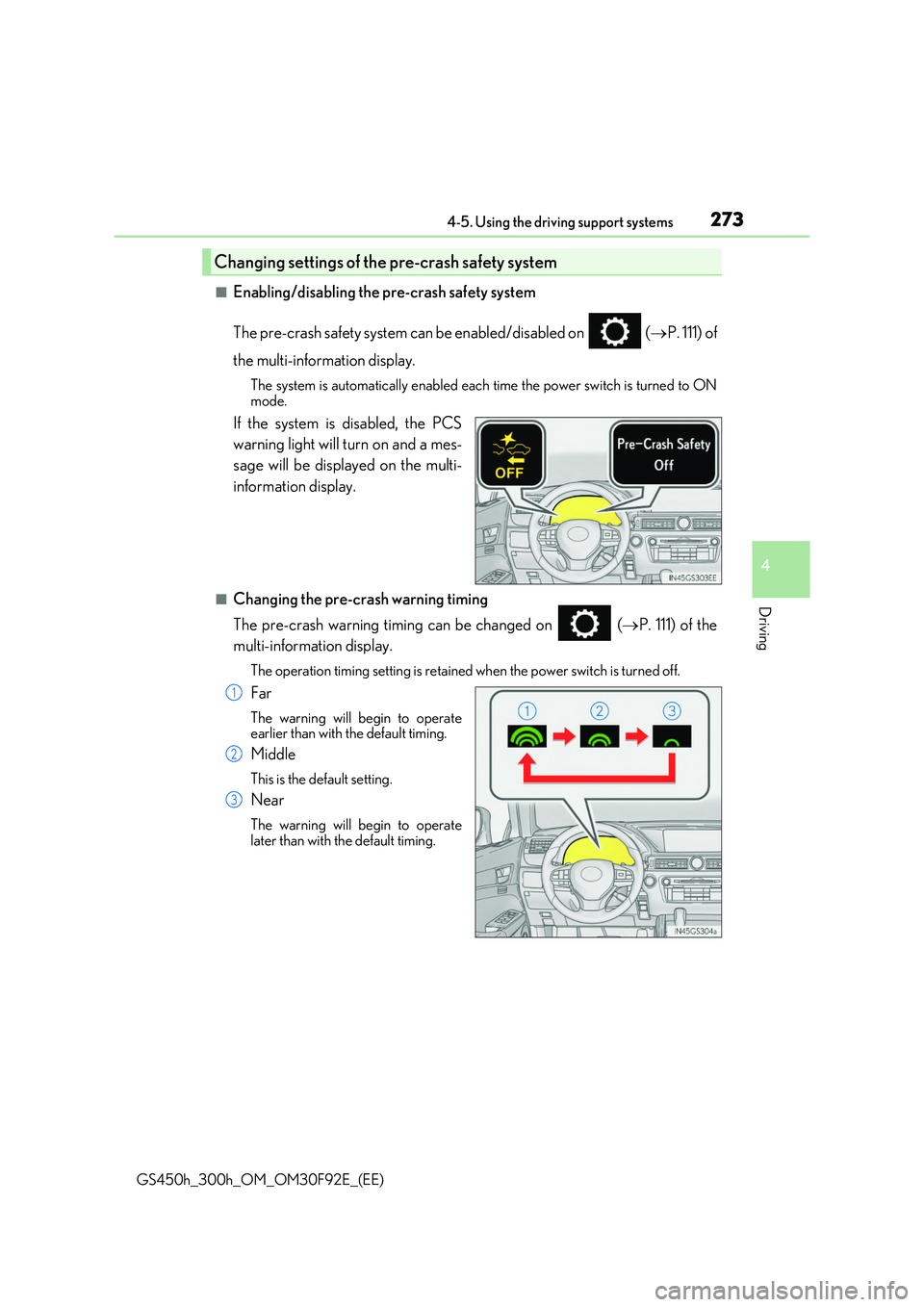
2734-5. Using the driving support systems
4
Driving
GS450h_300h_OM_OM30F92E_(EE)
■Enabling/disabling the pre-crash safety system
The pre-crash safety system can be enabled/disabled on ( P. 111) of
the multi-information display.
The system is automatically enabled each time the power switch is turned to ON mode.
If the system is disabled, the PCS
warning light will turn on and a mes-
sage will be displayed on the multi-
information display.
■Changing the pre-crash warning timing
The pre-crash warning timing can be changed on ( P. 111) of the
multi-information display.
The operation timing setting is retained when the power switch is turned off.
Far
The warning will begin to operate earlier than with the default timing.
Middle
This is the default setting.
Near
The warning will begin to operatelater than with the default timing.
Changing settings of the pre-crash safety system
1
2
3
Page 274 of 600
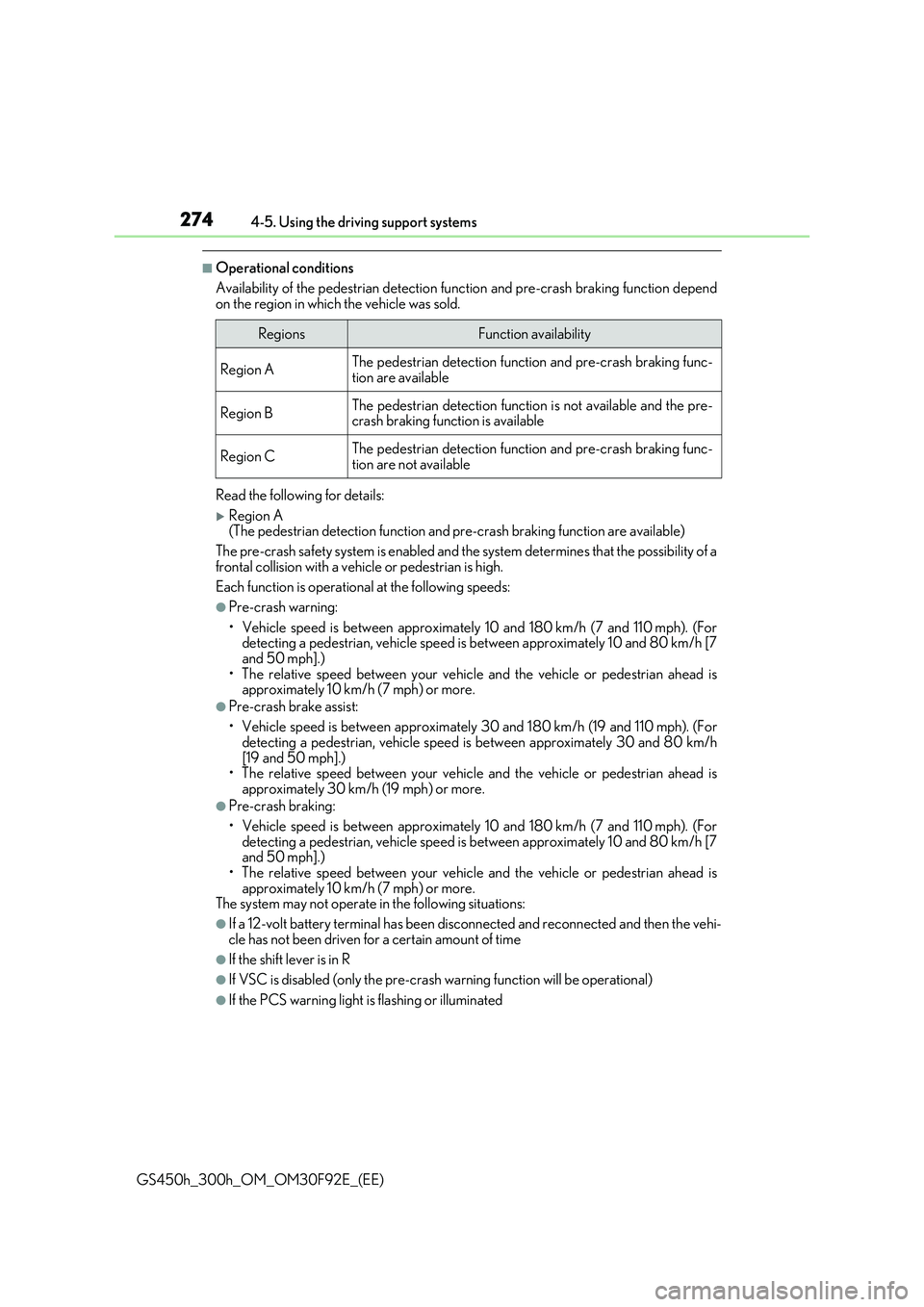
2744-5. Using the driving support systems
GS450h_300h_OM_OM30F92E_(EE)
■Operational conditions
Availability of the pedestrian detection func tion and pre-crash braking function depend on the region in which the vehicle was sold.
Read the following for details:
Region A (The pedestrian detection function and pre-crash braking function are available)
The pre-crash safety system is enabled and th e system determines that the possibility of a
frontal collision with a vehicle or pedestrian is high.
Each function is operational at the following speeds:
●Pre-crash warning:
• Vehicle speed is between approximately 10 and 180 km/h (7 and 110 mph). (For detecting a pedestrian, vehicle speed is between approximately 10 and 80 km/h [7and 50 mph].)
• The relative speed between your vehicle and the vehicle or pedestrian ahead is approximately 10 km/h (7 mph) or more.
●Pre-crash brake assist:
• Vehicle speed is between approximately 30 and 180 km/h (19 and 110 mph). (For detecting a pedestrian, vehicle speed is between approximately 30 and 80 km/h
[19 and 50 mph].) • The relative speed between your vehicle and the vehicle or pedestrian ahead isapproximately 30 km/h (19 mph) or more.
●Pre-crash braking:
• Vehicle speed is between approximately 10 and 180 km/h (7 and 110 mph). (For
detecting a pedestrian, vehicle speed is between approximately 10 and 80 km/h [7 and 50 mph].)• The relative speed between your vehicle and the vehicle or pedestrian ahead is
approximately 10 km/h (7 mph) or more. The system may not operate in the following situations:
●If a 12-volt battery terminal has been disconnected and reconnected and then the vehi-
cle has not been driven for a certain amount of time
●If the shift lever is in R
●If VSC is disabled (only the pre-cras h warning function will be operational)
●If the PCS warning light is flashing or illuminated
RegionsFunction availability
Region AThe pedestrian detection function and pre-crash braking func- tion are available
Region BThe pedestrian detection function is not available and the pre-crash braking function is available
Region CThe pedestrian detection function and pre-crash braking func-
tion are not available
Page 275 of 600
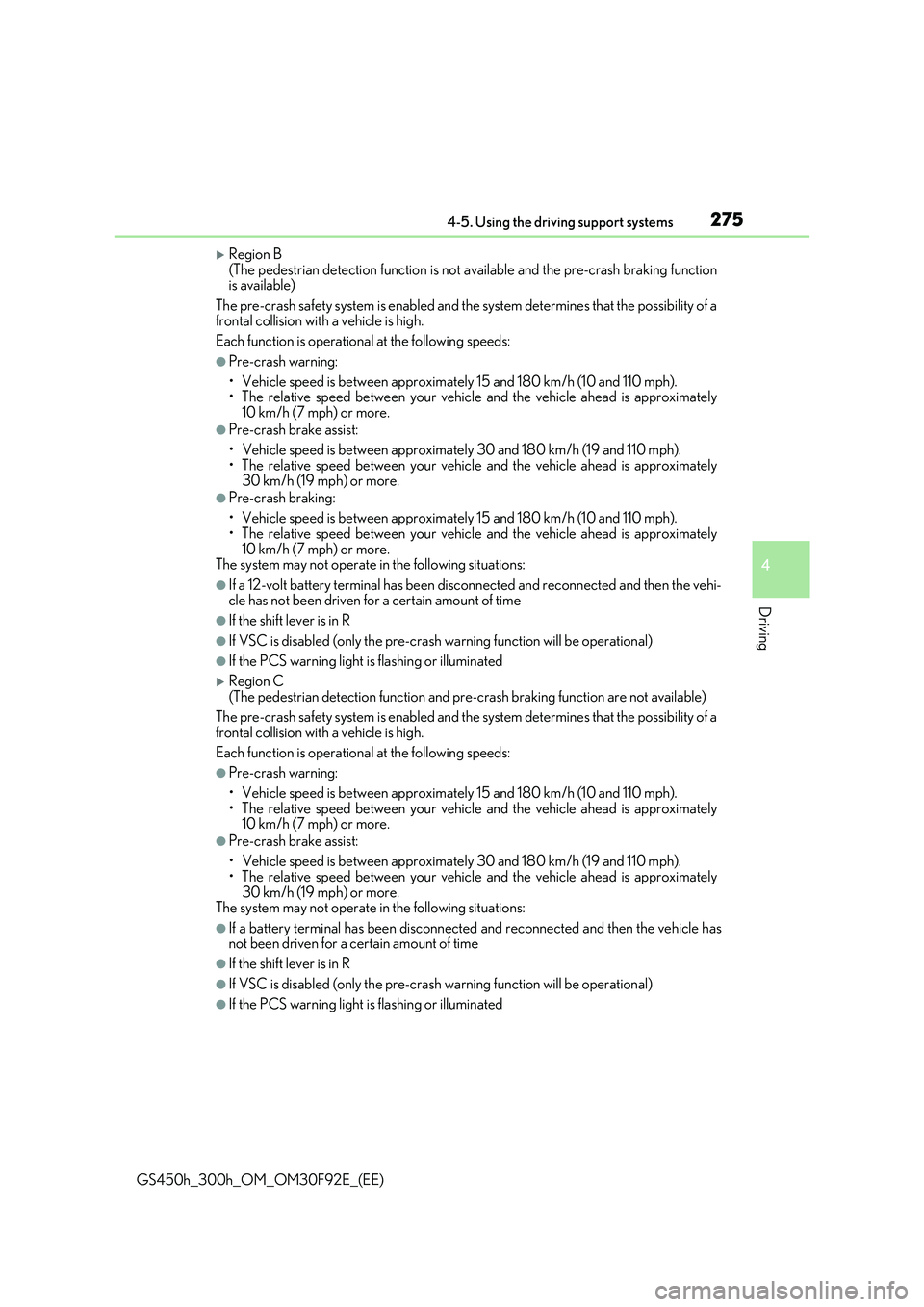
2754-5. Using the driving support systems
4
Driving
GS450h_300h_OM_OM30F92E_(EE)
Region B (The pedestrian detection function is not available and the pre-crash braking functionis available)
The pre-crash safety system is enabled and th e system determines that the possibility of a frontal collision with a vehicle is high.
Each function is operational at the following speeds:
●Pre-crash warning:
• Vehicle speed is between approximately 15 and 180 km/h (10 and 110 mph). • The relative speed between your vehicle and the vehicle ahead is approximately
10 km/h (7 mph) or more.
●Pre-crash brake assist:
• Vehicle speed is between approximately 30 and 180 km/h (19 and 110 mph). • The relative speed between your vehicle and the vehicle ahead is approximately30 km/h (19 mph) or more.
●Pre-crash braking:
• Vehicle speed is between approximately 15 and 180 km/h (10 and 110 mph).
• The relative speed between your vehicle and the vehicle ahead is approximately 10 km/h (7 mph) or more.The system may not operate in the following situations:
●If a 12-volt battery terminal has been disconnected and reconnected and then the vehi-cle has not been driven for a certain amount of time
●If the shift lever is in R
●If VSC is disabled (only the pre-cras h warning function will be operational)
●If the PCS warning light is flashing or illuminated
Region C
(The pedestrian detection function and pre-crash braking function are not available)
The pre-crash safety system is enabled and th e system determines that the possibility of a
frontal collision with a vehicle is high.
Each function is operational at the following speeds:
●Pre-crash warning:
• Vehicle speed is between approximately 15 and 180 km/h (10 and 110 mph). • The relative speed between your vehicle and the vehicle ahead is approximately10 km/h (7 mph) or more.
●Pre-crash brake assist:
• Vehicle speed is between approximately 30 and 180 km/h (19 and 110 mph).
• The relative speed between your vehicle and the vehicle ahead is approximately 30 km/h (19 mph) or more.The system may not operate in the following situations:
●If a battery terminal has been disconnected and reconnected and then the vehicle hasnot been driven for a certain amount of time
●If the shift lever is in R
●If VSC is disabled (only the pre-cras h warning function will be operational)
●If the PCS warning light is flashing or illuminated
Page 276 of 600
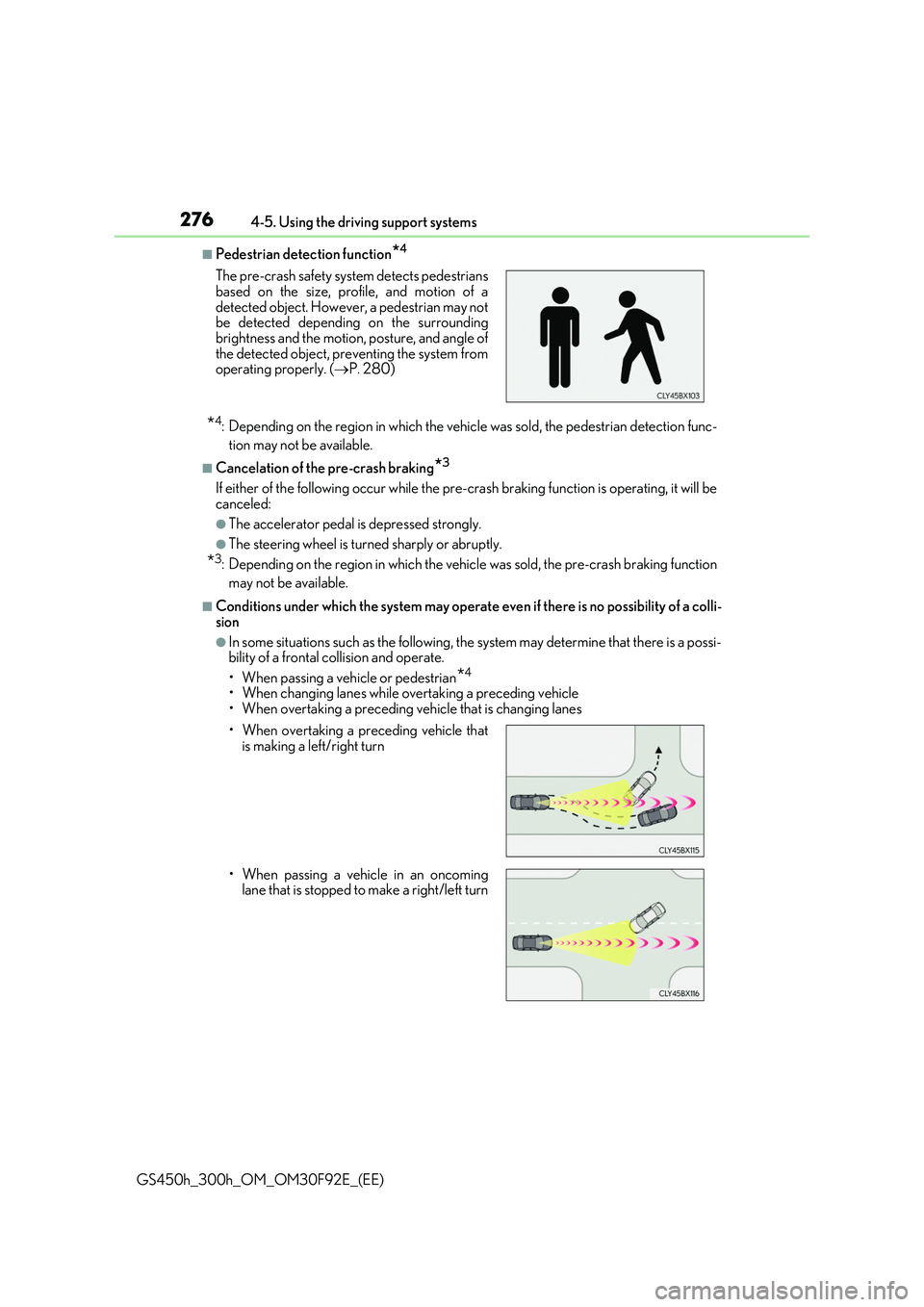
2764-5. Using the driving support systems
GS450h_300h_OM_OM30F92E_(EE)
■Pedestrian detection function*4
*4: Depending on the region in which the vehicle was sold, the pedestrian detection func-
tion may not be available.
■Cancelation of the pre-crash braking*3
If either of the following occur while the pre- crash braking function is operating, it will be canceled:
●The accelerator pedal is depressed strongly.
●The steering wheel is turned sharply or abruptly.
*3: Depending on the region in which the vehicle was sold, the pre-crash braking function
may not be available.
■Conditions under which the system may operate even if there is no possibility of a colli-
sion
●In some situations such as the following, the system may determine that there is a possi- bility of a frontal collision and operate.
• When passing a vehicle or pedestrian*4
• When changing lanes while overtaking a preceding vehicle • When overtaking a preceding vehicle that is changing lanes
The pre-crash safety syst em detects pedestrians
based on the size, profile, and motion of a detected object. However, a pedestrian may notbe detected depending on the surrounding
brightness and the motion, posture, and angle of the detected object, preventing the system fromoperating properly. ( P. 280)
• When overtaking a preceding vehicle that is making a left/right turn
• When passing a vehicle in an oncoming lane that is stopped to make a right/left turn
Page 277 of 600
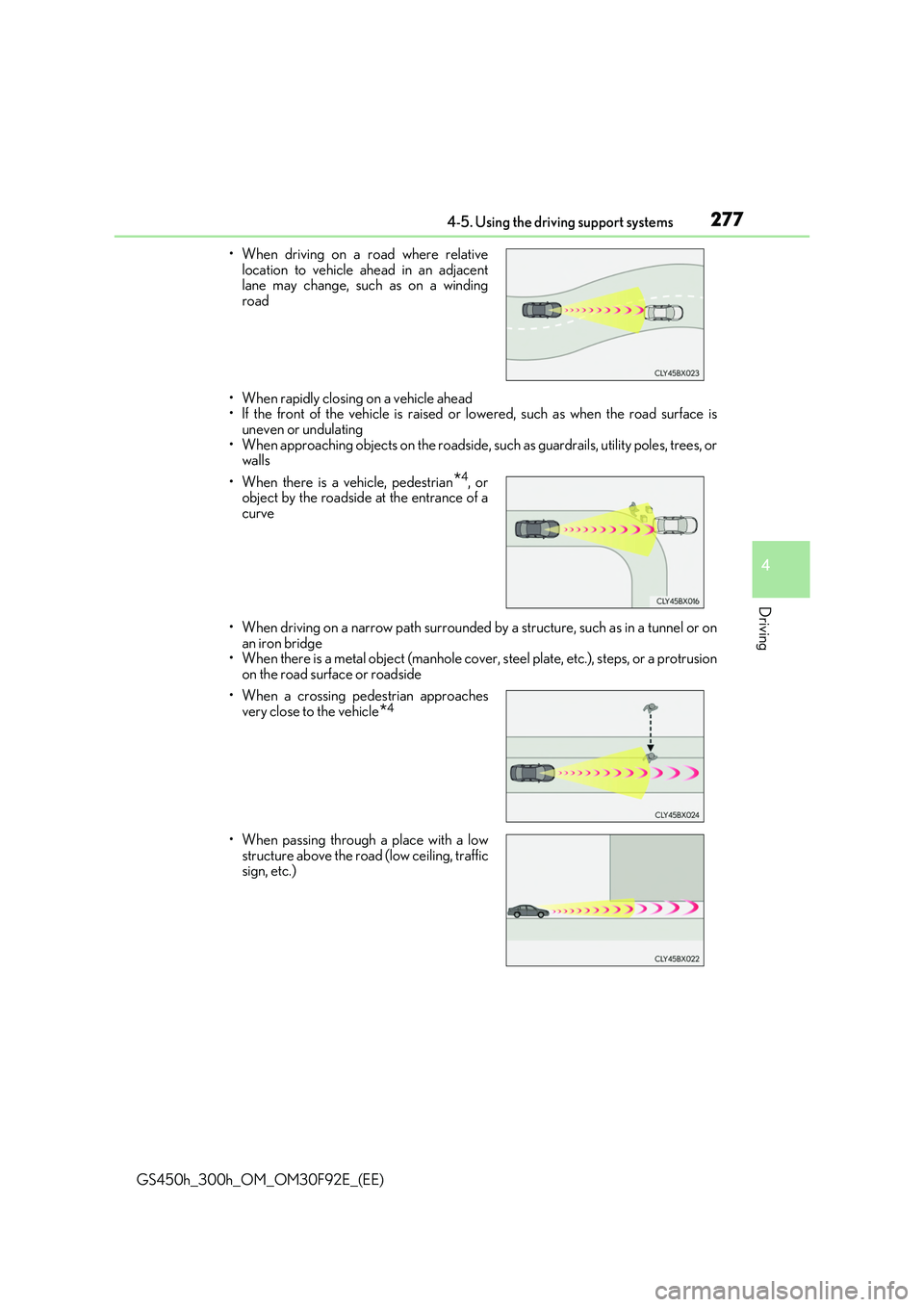
2774-5. Using the driving support systems
4
Driving
GS450h_300h_OM_OM30F92E_(EE)
• When rapidly closing on a vehicle ahead • If the front of the vehicle is raised or lowered, such as when the road surface isuneven or undulating
• When approaching objects on the roadside, such as guardrails, utility poles, trees, or walls
• When driving on a narrow path surrounded by a structure, such as in a tunnel or on an iron bridge• When there is a metal object (manhole cover, steel plate, etc.), steps, or a protrusion
on the road surface or roadside
• When driving on a road where relative location to vehicle ahead in an adjacentlane may change, such as on a winding
road
• When there is a vehicle, pedestrian*4, or object by the roadside at the entrance of acurve
• When a crossing pedestrian approaches
very close to the vehicle*4
• When passing through a place with a low
structure above the road (low ceiling, traffic sign, etc.)
Page 278 of 600
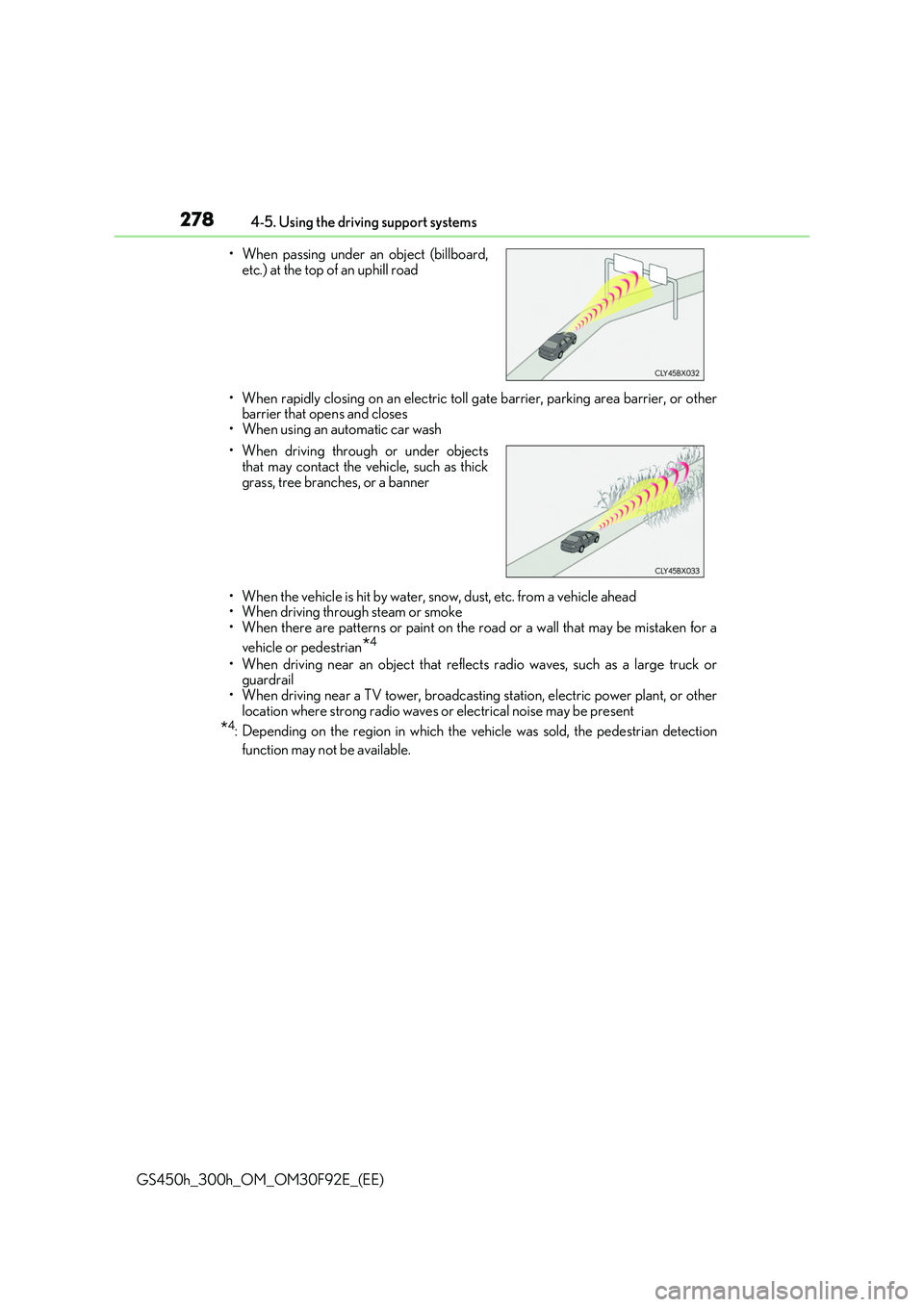
2784-5. Using the driving support systems
GS450h_300h_OM_OM30F92E_(EE)
• When rapidly closing on an electric toll gate barrier, parking area barrier, or other barrier that opens and closes• When using an automatic car wash
• When the vehicle is hit by water, snow, dust, etc. from a vehicle ahead • When driving through steam or smoke
• When there are patterns or paint on the road or a wall that may be mistaken for a
vehicle or pedestrian*4
• When driving near an object that reflects radio waves, such as a large truck or guardrail
• When driving near a TV tower, broadcasting station, electric power plant, or other location where strong radio waves or electrical noise may be present
*4: Depending on the region in which the vehicle was sold, the pedestrian detection
function may not be available.
• When passing under an object (billboard, etc.) at the top of an uphill road
• When driving through or under objects that may contact the vehicle, such as thick
grass, tree branches, or a banner
Page 279 of 600
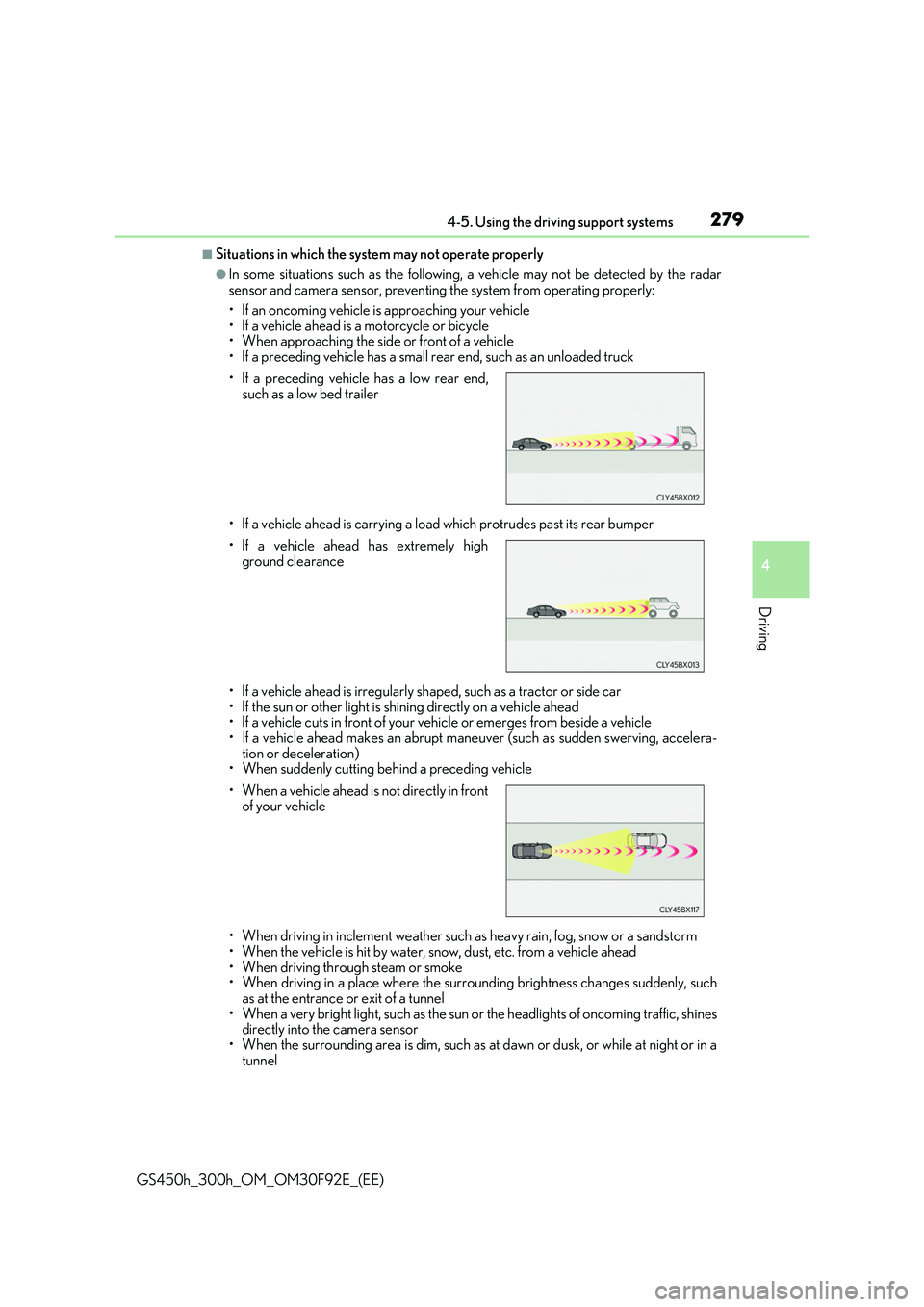
2794-5. Using the driving support systems
4
Driving
GS450h_300h_OM_OM30F92E_(EE)
■Situations in which the system may not operate properly
●In some situations such as the following, a vehicle may not be detected by the radar sensor and camera sensor, preventing the system from operating properly:
• If an oncoming vehicle is approaching your vehicle • If a vehicle ahead is a motorcycle or bicycle• When approaching the side or front of a vehicle
• If a preceding vehicle has a small rear end, such as an unloaded truck
• If a vehicle ahead is carrying a load which protrudes past its rear bumper
• If a vehicle ahead is irregularly sh aped, such as a tractor or side car
• If the sun or other light is shin ing directly on a vehicle ahead • If a vehicle cuts in front of your vehicle or emerges from beside a vehicle• If a vehicle ahead makes an abrupt mane uver (such as sudden swerving, accelera-
tion or deceleration) • When suddenly cutting behind a preceding vehicle
• When driving in inclement we ather such as heavy rain, fog, snow or a sandstorm • When the vehicle is hit by water, snow, dust, etc. from a vehicle ahead
• When driving through steam or smoke • When driving in a place where the surro unding brightness changes suddenly, such as at the entrance or exit of a tunnel
• When a very bright light, such as the sun or the headlights of oncoming traffic, shines directly into the camera sensor• When the surrounding area is dim, such as at dawn or dusk, or while at night or in a
tunnel
• If a preceding vehicle has a low rear end,
such as a low bed trailer
• If a vehicle ahead has extremely high
ground clearance
• When a vehicle ahead is not directly in front of your vehicle
Page 280 of 600
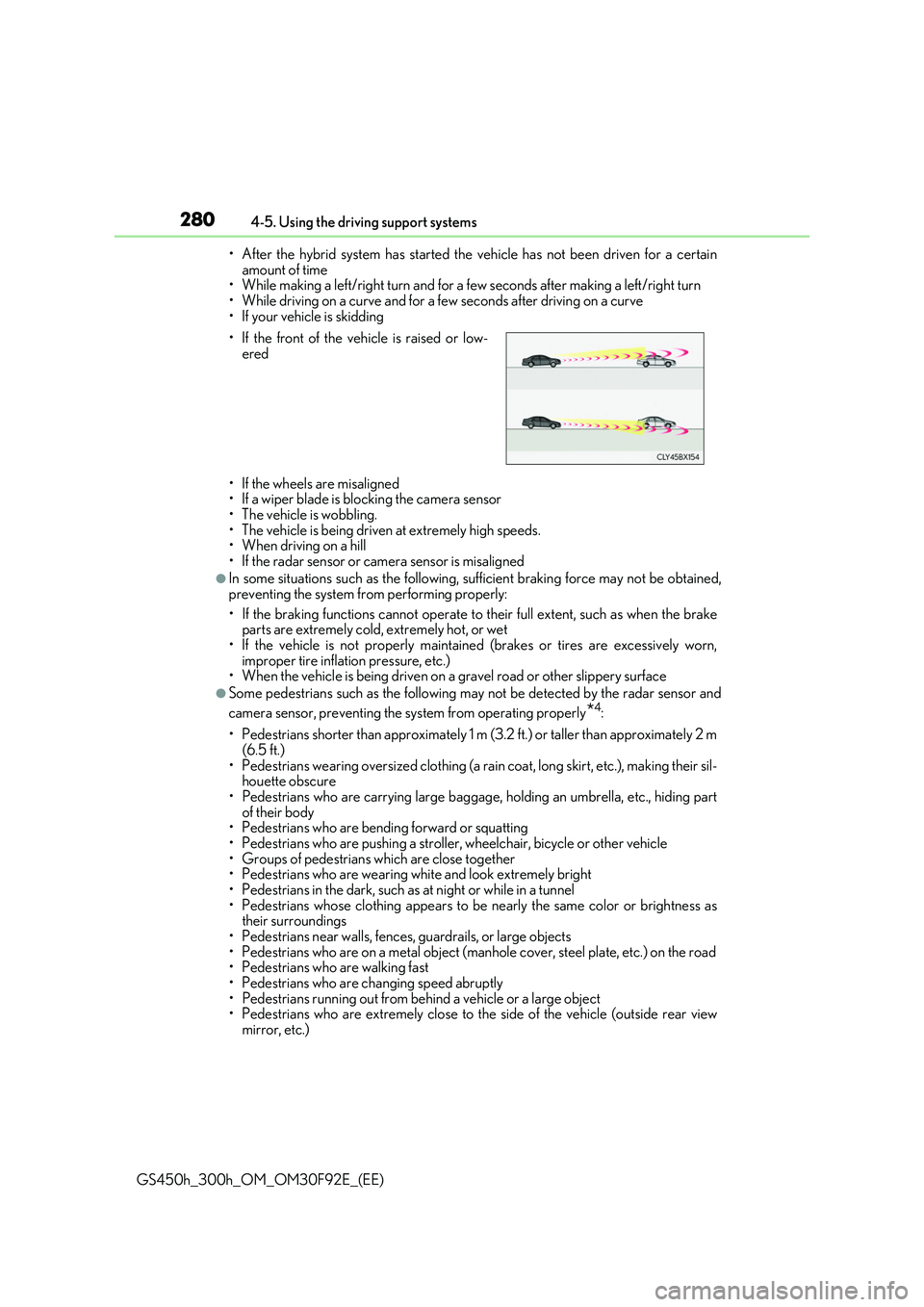
2804-5. Using the driving support systems
GS450h_300h_OM_OM30F92E_(EE)
• After the hybrid system has started the vehicle has not been driven for a certain amount of time• While making a left/right turn and for a few seconds after making a left/right turn
• While driving on a curve and for a few seconds after driving on a curve • If your vehicle is skidding
• If the wheels are misaligned • If a wiper blade is blocking the camera sensor
• The vehicle is wobbling. • The vehicle is being driven at extremely high speeds.• When driving on a hill
• If the radar sensor or camera sensor is misaligned
●In some situations such as the following, sufficient braking force may not be obtained,
preventing the system from performing properly:
• If the braking functions cannot operate to their full extent, such as when the brake parts are extremely cold, extremely hot, or wet
• If the vehicle is not properly maintained (brakes or tires are excessively worn, improper tire inflation pressure, etc.)• When the vehicle is being driven on a gravel road or other slippery surface
●Some pedestrians such as the following may not be detected by the radar sensor and
camera sensor, preventing the system from operating properly*4:
• Pedestrians shorter than approximately 1 m (3 .2 ft.) or taller than approximately 2 m
(6.5 ft.) • Pedestrians wearing oversized clothing (a rain coat, long skirt, etc.), making their sil- houette obscure
• Pedestrians who are carrying large baggage, holding an umbrella, etc., hiding part of their body• Pedestrians who are bending forward or squatting
• Pedestrians who are pushing a stroller , wheelchair, bicycle or other vehicle • Groups of pedestrians which are close together• Pedestrians who are wearing white and look extremely bright
• Pedestrians in the dark, such as at night or while in a tunnel • Pedestrians whose clothing appears to be nearly the same color or brightness astheir surroundings
• Pedestrians near walls, fences, guardrails, or large objects • Pedestrians who are on a metal object (manhole cover, steel plate, etc.) on the road• Pedestrians who are walking fast
• Pedestrians who are changing speed abruptly • Pedestrians running out from be hind a vehicle or a large object • Pedestrians who are extremely close to the side of the vehicle (outside rear view
mirror, etc.)
• If the front of the vehicle is raised or low- ered